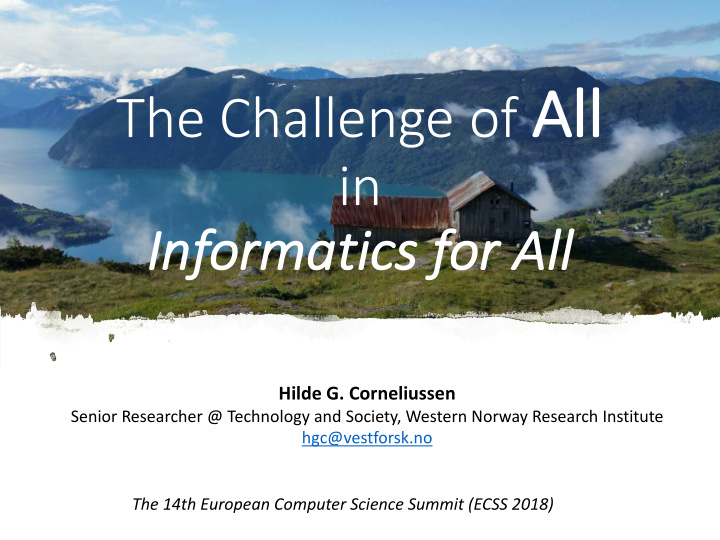



The Challenge of Al All in In Informa rmatic ics for r All All Hilde G. Corneliussen Senior Researcher @ Technology and Society, Western Norway Research Institute hgc@vestforsk.no The 14th European Computer Science Summit (ECSS 2018)
Women’s participating in academic fields Norway ______________ _______ ______________ Hilde G. Corneliussen hgc@vestforsk.no
Norway and EU ______________ _______ ______________ Hilde G. Corneliussen hgc@vestforsk.no
USA ______________ _______ ______________ Hilde G. Corneliussen hgc@vestforsk.no
“My mother was a computer" “Human computers” Washington, D.C. "Bonus Bureau, Computing Division, 1924 ______________ _______ ______________ Hilde G. Corneliussen hgc@vestforsk.no
The first programmers - 1945 ENIAC - Electronic Numerical Integrator and Computer ______________ _______ ______________ Hilde G. Corneliussen hgc@vestforsk.no
The first programmers - 1945 ENIAC - Electronic Numerical Integrator and Computer Somebody gave us a whole stack of blueprints, and these were the wiring diagrams for all the panels, and they said 'Here, figure out how the machine works and then figure out how to program it' ______________ _______ ______________ Hilde G. Corneliussen hgc@vestforsk.no
Cut out.. ______________ _______ ______________ Hilde G. Corneliussen hgc@vestforsk.no
.. and forgotten Kathy Kleiman (student) 1980s: “Who are the women in the photo?" A computer historian told her: “They are just ‘Refrigerator Ladies’ – models posing in front of the machine to make it look good“ ______________ _______ ______________ Hilde G. Corneliussen hgc@vestforsk.no
The computer business was unusually open to women in the 1950s and 60s I was hired a programmer … It was something that women were believed to be good at (1950s) It really amazed me that these men were programmers, because I thought it was women's work! (1950s) It never occurred to any of us that computer programming would eventually become something that was thought of as a men's field "(1960s) Abbate, J. (2012). Recoding Gender. Women's Changing Participation in Computing ______________ _______ ______________ Hilde G. Corneliussen hgc@vestforsk.no
Professional identity “Compared to most technical professions, computer programming was unusually open to females. But on the other hand, in the late 1960s the computer programming community was also actively making itself masculine, pursuing a strategy of professional development that would eventually make it one of the most stereotypically male professions, inhospitable to all but the most adventurous and unconventional women” Ensmenger, N. (2010). Making Programming Masculine. In T. J. Misa (Ed.), Gender Codes: Why Women are Leaving Computing ______________ _______ ______________ Hilde G. Corneliussen hgc@vestforsk.no
Recruiting women… «Computing is more about human beings than about machines. NTNU wants more girls…» ______________ _______ ______________ Hilde G. Corneliussen hgc@vestforsk.no
The challenge of “All” is a question of belonging ______________ _______ ______________ Hilde G. Corneliussen hgc@vestforsk.no
Recommend
More recommend